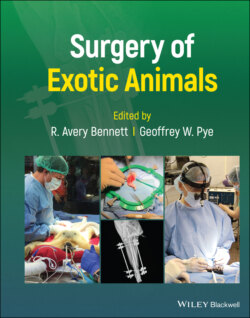Читать книгу Surgery of Exotic Animals - Группа авторов - Страница 124
Skin Surgery
ОглавлениеThere are a number of indications for skin biopsy. Perform a local anesthesia block with lidocaine 2 mg/kg and obtain the biopsy with a sterile punch biopsy instrument or scissors. Use hand‐held electrocautery to achieve hemostasis, if needed. For skin closure, use a cutaneous everting pattern (Figure 6.3), appositional sutures, and/or cyanoacrylate tissue adhesive (Tuttle et al. 2006; Gentz 2007; Van Bonn 2009; Baitchman and Herman 2015; Chai 2015a). Appositional sutures are preferred by the authors. Take care to minimize suture tension as amphibian cutaneous tissue is less elastic than mammalian skin (Chai 2015a). This is not always possible when large margins are needed for excising neoplasms. To relieve tension, use silicone rubber tubing as stents on each side of the incision (Wright and Whitaker 2001a).
Figure 6.3 Cutaneous everting suture pattern with monofilament absorbable suture material on the right forelimb of a cane toad (Bufo marinus).
Source: Photo courtesy: Zoological Medicine Service, Université de Montréal.
Cryosurgery and laser surgery have been used in amphibians for mass ablation (Wright and Whitaker 2001a). These modalities improve hemostasis, but do not enable histologic analysis of the mass. A protocol of three freeze‐thaw cycles over 30 seconds for each phase using a thermocouple has been described. If cryosurgery is elected and histopathology is needed, first collect an incisional biopsy of the mass. Chemical cauterization, such as with formalin and metacresolsulfonic acid (Lotagen TM, Schering Plough Animal Health), has been used to remove cutaneous masses in amphibians (Chai 2015a); however, controlled studies are needed to evaluate tissue healing, adverse effects, and pain associated with this technique.
